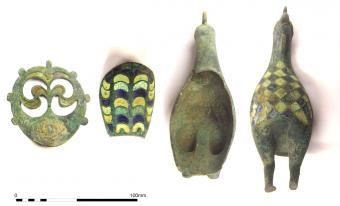A rare Roman figurine of cockerel has been unearthed at a dig in Cirencester, Gloucestershire, England.
Cirencester was the second largest Roman town in Britain and the object was uncovered during a dig at a Roman burial site. It is believed to date to the middle of the second century AD.
The bronze figurine measures 5 inches long and was found in a child’s grave. The cockerel’s breast, wings, eyes and comb are inlaid with green, yellow and blue enamel, and has a separate plate at the tail. Its beak is open as if crowing.
Only four such figurines have been discovered in the UK and a total of eight are known to have been found in the former Roman Empire. It is said to be one of the finest pieces of its kind.
The figurine was unearthed in 2011 and conservation work has revealed its high quality of workmanship, suggesting that the buried child’s family was wealthy. Experts believe the cockerel figure represents the ancient messenger to the gods, Mercury, who conducted souls to the afterlife. Archaeologists believe it was an offering to Mercury to guarantee the child’s safe passage to the afterlife.
The chief executive for Cotswold Archaeology, Neil Holbrook, said: “The cockerel is the most spectacular find from more than 60 Roman burials excavated at this site. It was excavated from the grave of young child and was placed close to its head. Interestingly a very similar item was found in Cologne in Germany and it looks like they both could have come from the same workshop based in Britain.”
The cockerel will go on display at the town’s Corinium Museum.









